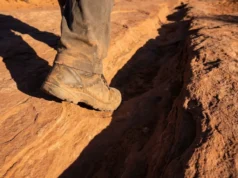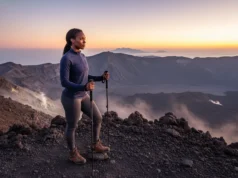In this article
Moving beyond the casual tourist trails, this is a strategic deep dive into the most challenging and rewarding hikes Olympic National Park has to offer. For the dedicated hiker seeking solitude, strenuous adventure, and the profound beauty found miles from any road, the experience of hiking at olympic national park is unparalleled. The park’s true character is not found at a roadside viewpoint but deep within its vast, roadless wilderness—a place for experienced adventurers. You’ll find a curated selection of the park’s most demanding trails, focusing on the unique challenges of its alpine, coastal, and rainforest ecosystems. This guidance is crafted for the physically fit hiker who is comfortable with significant elevations, technical terrain, and the complex logistics of a backpacking trip.
The Olympic Gauntlet: A Triumvirate of Terrains
Olympic National Park presents a gauntlet of three distinct and challenging ecosystems. Understanding the unique demands of the alpine realm, wilderness coast, and rainforest depths is the foundational first step in preparing for a serious expedition.
The Alpine Realm: High Peaks and Sweeping Vistas
The character of the alpine realm is defined by the subalpine meadows, rocky ridges, and airy summits that form the park’s core. Venturing into this zone on a day hike rewards the hiker with stunning panoramic views of Mount Olympus, the Cascade Range, and the Puget Sound. However, these vistas are hard-won. The primary challenge is the relentless elevation gain found on trails like Mount Ellinor, paired with total exposure to fickle and rapidly changing weather. Summer thunderstorms can materialize quickly, so checking the current weather conditions in the park is a non-negotiable first step.
A significant seasonal challenge is the lingering snowpack, which can persist on high-elevation trails well into July. This means that what is a simple trail in August is a dangerous, steep snow field in June. For safe passage, tools like an ice axe and microspikes are not optional luxuries; they are essential safety equipment. More importantly, the knowledge of its use essential for self-arrest is the skill that can prevent a simple slip from becoming a catastrophic fall.
The Wilderness Coast: Where Tides Dictate Passage
The Olympic Wilderness Coast is one of the most primitive and untamed stretches of shoreline in the contiguous United States. This technical endurance hike is a real hike, not a casual beach walk. The “trail” is a punishing surface of soft sand, dangerously slick boulders, and massive driftwood logs that must be scrambled over. The most critical and unforgiving challenge here is the tide. Many of the rocky headlands are completely impassable during high tide, forcing you to either wait for hours or navigate treacherous, muddy overland trails.
A miscalculation of the tides is not a mere inconvenience; it can be a life-threatening mistake, trapping you against impassable cliffs. Additional challenges, like creek fords that swell with rain, can slow your pace to as little as five to ten miles per day. This unforgiving environment dictates your schedule, reinforcing the fact that even the strongest hikers are subject to the powerful rhythm of the ocean.
The Rainforest Depths: Journeys into a Primeval World
To hike deep into the Hoh, Quinault, or Queets rainforest valleys is to enter another world. The experience is profoundly immersive, with evocative descriptions like “cathedral rain forest” and “prehistoric atmosphere” only beginning to capture the feeling of solitude and ancientness. The landscape is dominated by massive, moss-draped maples and thousand-year-old Sitka spruce trees. As a designated UNESCO World Heritage Site, it is a sanctuary for both wildlife and the hikers who seek it.
The main challenges of these rainforest treks are distance, remoteness, and endurance. These are long backpacking expeditions on trails that are often muddy, overgrown, and involve numerous unbridged stream crossings within the dense forest that test your balance and resolve. The ultimate reward for this perseverance is an intimate experience with one of the last primeval forests in the lower 48 states and the chance to spot wildlife like Roosevelt elk and black bears in their natural habitat.
The Premier Trails: A Curated Selection for the Adventurous
The premier trails listed here were chosen specifically for their ability to challenge and reward the dedicated hiker. A scannable comparison table is followed by in-depth profiles that blend hard data with essential on-the-ground intel about these iconic hikes.
Olympic’s Premier Trails at a Glance
The table allows for a quick assessment of each route’s core metrics, including its region, type, distance, elevation gain, and difficulty. Pay special attention to the “Ultimate Reward” column, as it distills the unique payoff—the specific, motivating reason—that makes each demanding hike worthwhile.
Top Olympic National Park Trails
An interactive guide to the best hikes and backpacking trips in Olympic National Park, detailing difficulty, distance, and what makes each trail special.
Region
Southeast / Hood Canal
Type
Day Hike
Distance (RT)
6.2 mi
Elevation Gain
3,300 ft
The Ultimate Reward
360° views of the Olympics, Lake Cushman, Hood Canal, and the Cascade volcanoes.
Region
Sol Duc
Type
Backpacking Loop
Distance (RT)
19 mi
Elevation Gain
5,000 ft
The Ultimate Reward
Iconic, sweeping views of Mount Olympus and the pristine alpine lakes of the Seven Lakes Basin.
Region
Lake Crescent
Type
Day Hike
Distance (RT)
4.1-5.3 mi
Elevation Gain
~2,100 ft
The Ultimate Reward
The adrenaline of the rope-assisted scramble to a breathtaking, iconic overlook of Lake Crescent.
Region
Pacific Coast
Type
Day Hike / Backpack
Distance (RT)
8.8 mi
Elevation Gain
590 ft
The Ultimate Reward
The quintessential wild Olympic Coast experience with dramatic sea stacks.
Region
Hoh Rainforest
Type
Backpacking
Distance (RT)
36 mi
Elevation Gain
5,400 ft
The Ultimate Reward
A journey from a temperate rainforest to the terminal moraine of the Blue Glacier.
Region
Quinault
Type
Backpacking
Distance (RT)
26 mi
Elevation Gain
2,700 ft
The Ultimate Reward
The “Valley of 10,000 Waterfalls” and the historic chalet.
Region
Hurricane Ridge
Type
Day Hike
Distance (RT)
~7.0 mi+
Elevation Gain
~2,000 ft+
The Ultimate Reward
Panoramic ridge-walking with a challenging final rock scramble to a 360° summit view.
Mount Storm King – The Adrenaline Overlook
Mount Storm King is a rite of passage for many Washington hikers. It has earned its “bucket-list” status by delivering an intense physical challenge and an iconic photographic payoff overlooking the stunningly blue waters of Lake Crescent. The trailhead is at the Storm King Ranger Station, sharing an easy path with Marymere Falls before a sharp turn marks the beginning of a relentless ascent. A National Park Pass is required for parking.
The “gauntlet” of this hike is its infamous, unmaintained ropes section beyond the official trail’s end. This is where the true adventure begins. The route transforms into a steep, exposed, and unmaintained scramble over loose rock and dirt. A series of ropes, placed and maintained by unknown individuals, assist the climb. The National Park Service does not inspect these ropes; using them is entirely at your own risk. This good climb requires significant upper body strength and a steady nerve. Always check for the most up-to-date current wilderness trail conditions before attempting any technical route.
Hoh River Trail to Blue Glacier – The Ultimate Rainforest-to-Alpine Traverse
This hike is the grand traverse of the Hoh Rainforest, a true bucket-list expedition for the serious backpacker. It is a journey of profound contrasts, beginning in the impossibly green heart of the temperate rainforest and culminating at the raw, icy power of the Blue Glacier on the flanks of Mount Olympus. The trailhead parking lot is at the Hoh Rain Forest Visitor Center, where you should plan to arrive early to secure parking.
The primary challenge is sheer endurance. The 36-mile round trip involves a grueling 5,400 feet of elevation gain, most of it packed into the final, leg-burning miles. This mile trail is often muddy and requires navigating a washed-out section with a fixed rope ladder. For early-season winter or spring travel, an ice axe and crampons are essential to safely cross steep snow fields. This is a serious undertaking requiring mandatory Wilderness Camping Permits for designated campsites and bear canisters, both of which must be secured on Recreation.gov well in advance of your trip to the terminal moraine of the Blue Glacier.
The Backcountry Strategist: Your Expedition Blueprint
A successful backpacking trip in Olympic National Park relies on an essential logistical framework. It covers the critical, non-negotiable details of mastering the permit system, assembling terrain-specific gear, and understanding advanced safety protocols for your adventure.
Mastering the Olympic Permit Maze
Navigating the permit system is the first logistical challenge. For trailhead parking, you may need one of three passes depending on location: a National Park Pass for areas like the Hoh Rainforest and Hurricane Ridge, a Northwest Forest Pass for trails in the Olympic National Forest like Mount Ellinor, or a Makah Recreation Pass for access to Shi Shi Beach, which must be purchased in person in Neah Bay.
For any overnight stay, a Wilderness Camping Permit is mandatory. The old system of self-registration at trailheads no longer exists; all permits must be reserved in advance via Recreation.gov.
[PRO-TIP] The single most important date for planning a summer backpacking trip is April 15th at 7:00 AM Pacific Time. This is when reservations open for the entire peak season. Highly competitive “quota” campsites, like those in the Sol Duc/Seven Lakes Basin, can be fully booked within minutes.
The fee structure includes a $6 reservation fee plus an $8 per person, per night fee. Frequent backpackers can save money with the $45 Annual Olympic National Park Wilderness Pass, which covers the nightly recreation fees for the pass holder.
Gearing for the Olympic Challenge: A Terrain-Specific Matrix
A generic “Ten Essentials” list is insufficient for Olympic’s diverse mountain terrains. While you should always carry The Ten Essentials, a nuanced, terrain-specific approach is critical for safety and success. The matrix below provides targeted recommendations for everything from hiking poles to backpacks. For instance, the critical insight that stiff, lug-soled boots perform poorly on slick coastal rocks is an expert tip that could prevent a serious fall. Similarly, knowing that GPS signals are unreliable in deep rainforest valleys underscores the need for map and compass skills, which you can refresh at any of the park’s Wilderness Information Centers (WICs).
Gear Recommendations by Terrain
Essential equipment for Alpine Ascents, Coastal Traverses, and Rainforest Treks.
Alpine Ascents
Sturdy, waterproof boots for ankle support.
Coastal Traverses
Flexible-soled boots. Bring water shoes for crossings. Hard lug-soles have poor traction on slick, wet coastal rocks. Flexible soles offer better grip.
Rainforest Treks
Waterproof boots or quick-draining trail runners.
Alpine Ascents
Topo Map, Compass, Altimeter. GPS as backup.
Coastal Traverses
Topo Map, Compass, Tide Chart, Watch. A tide chart is a non-negotiable, life-saving tool for the coast.
Rainforest Treks
Topo Map, Compass, GPS (with known limitations). GPS is unreliable under a dense canopy.
Alpine Ascents
Ice Axe, Microspikes (for early season). Ice axe proficiency is essential for high-country travel before late July when steep snow is common.
Coastal Traverses
–
Rainforest Treks
–
Alpine Ascents
Bear Canister (Required in many areas). Regulations are strict. Always check the specific requirements for your route.
Coastal Traverses
Bear Canister (Required). Regulations are strict. Always check the specific requirements for your route.
Rainforest Treks
Bear Wires (some sites) or Bear Canister (Required in others). Regulations are strict. Always check the specific requirements for your route.
Alpine Ascents
Non-cotton layers, full rain gear, sun hat, gloves. Cotton is dangerously unsuitable for the Pacific Northwest. Rain is possible any day of the year.
Coastal Traverses
Non-cotton layers, full rain gear, sturdy gaiters. Cotton is dangerously unsuitable for the Pacific Northwest. Rain is possible any day of the year.
Rainforest Treks
Non-cotton layers, full rain gear, sturdy gaiters. Cotton is dangerously unsuitable for the Pacific Northwest. Rain is possible any day of the year.
Alpine Ascents
The Ten Essentials, hiking poles, headlamp, water filter/purifier. Hiking poles are invaluable for saving knees on steep descents and maintaining balance on the trail.
Coastal Traverses
The Ten Essentials, hiking poles, headlamp, water filter/purifier. Hiking poles are invaluable for saving knees on steep descents and maintaining balance on the trail.
Rainforest Treks
The Ten Essentials, hiking poles, headlamp, water filter/purifier. Hiking poles are invaluable for saving knees on steep descents and maintaining balance on the trail.
Advanced Safety & Wilderness Ethics
Beyond gear, success requires understanding specific hazards and adhering to the highest standards of wilderness ethics. On the coast, you must use a tide chart with your map to time your arrival at tidal headlands for a falling or low tide. This is a critical life-safety skill. Likewise, you must understand the park’s “Rain Shadow” effect; the western valleys receive immense rain while the eastern side is much drier. Always pack for rain, even on a sunny day.
For the dedicated hiker on their wilderness trip seeking solitude, employ crowd-avoidance tactics. Choose less-famous trails—like Pyramid Peak instead of Storm King—or time your visit for mid-week or off-peak hours. Finally, practice an expert’s code of Leave No Trace. In sensitive environments, this means you must be prepared to pack out human waste using specialized “Wag Bags.” All used toilet paper must always be packed out, as it does not decompose and is a primary source of visual pollution.
Conclusion: Answering the Call of the Wild
This dreamy park offers a lifetime of challenges and rewards, but its true character is revealed deep within its three distinct and demanding ecosystems. The premier backpacking trails and day hikes detailed here—from the technical scramble up Mount Storm King to the epic journey to Blue Glacier—are gateways to experiences of solitude, immense beauty, and profound personal accomplishment. Success in these endeavors hinges on meticulous planning, a respect for the power of the landscape, and a commitment to leaving these wild places pristine. By mastering the permit system, selecting strategic gear, and adhering to advanced safety ethics, the dedicated hiker can access the very heart of the Olympic Peninsula wilderness. The challenges are significant, but the effort is an integral part of the reward.
What’s the most challenging trail you’ve ever hiked in Olympic National Park? Share your experience and tips in the comments below!
Frequently Asked Questions about Hiking in Olympic National Park
What is the most beautiful hike in Olympic National Park?
“Most beautiful” is subjective and depends on your preferred scenery. For iconic hikes with alpine lakes and views, the High Divide Loop is a top contender. For dramatic coastal sea stacks, choose Shi Shi Beach, and for a primeval rainforest experience, the Hoh River Trail is unmatched.
How many days do you need for Olympic National Park hiking?
You could spend a lifetime exploring. However, a good trip requires at least 3-4 days to experience the park’s three distinct ecosystems. For a single, serious backpacking route like the High Divide Loop, a dedicated 2-4 day trip is common.
What is the most famous trail in the Hoh Rainforest?
The Hoh River Trail is the most famous route, starting from the visitor center. While most casual visitors walk the short Hall of Mosses Trail, the full Hoh River Trail is the renowned multi-day backpacking trip toward Mount Olympus.
Can you hike Olympic National Park in a day?
You can certainly take a day hike, but you cannot hike the entire million-acre park in a day. For a dedicated hiker, strenuous and rewarding day hikes like Mount Ellinor or Mount Storm King showcase what amazing objectives can be accomplished in a single day.
Risk Disclaimer: Hiking, trekking, backpacking, and all related outdoor activities involve inherent risks which may result in serious injury, illness, or death. The information provided on The Hiking Tribe is for educational and informational purposes only. While we strive for accuracy, information on trails, gear, techniques, and safety is not a substitute for your own best judgment and thorough preparation. Trail conditions, weather, and other environmental factors change rapidly and may differ from what is described on this site. Always check with official sources like park services for the most current alerts and conditions. Never undertake a hike beyond your abilities and always be prepared for the unexpected. By using this website, you agree that you are solely responsible for your own safety. Any reliance you place on our content is strictly at your own risk, and you assume all liability for your actions and decisions in the outdoors. The Hiking Tribe and its authors will not be held liable for any injury, damage, or loss sustained in connection with the use of the information herein.
Affiliate Disclosure: We are a participant in the Amazon Services LLC Associates Program, an affiliate advertising program designed to provide a means for us to earn advertising fees by advertising and linking to Amazon.com. As an Amazon Associate, we earn from qualifying purchases. We also participate in other affiliate programs and may receive a commission on products purchased through our links, at no extra cost to you. Additional terms are found in the terms of service.





